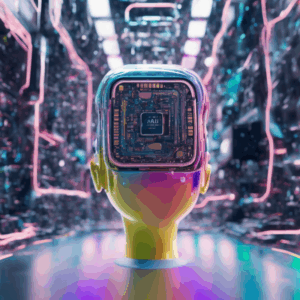1. Biometric Identification: Striking a Balance Between Security and Privacy
Biometric identification technology has revolutionized border control and immigration enforcement, allowing for faster and more accurate identification of individuals. However, the use of biometric data raises concerns about the potential infringement of individual rights and privacy. Should there be restrictions on its use? Let’s delve into this complex issue.
2. The Importance of Individual Rights and Privacy
Protecting individual rights and privacy is a cornerstone of democratic societies. Citizens have the right to control their personal information and be free from unwarranted surveillance. As technology advances, it becomes crucial to strike a balance between national security and the protection of these fundamental rights.
3. Potential for Abuse and Discrimination
One of the main arguments against unrestricted use of biometric identification in border control and immigration enforcement is the potential for abuse and discrimination. Critics argue that if not properly regulated, biometric data could be misused to target specific ethnic or religious groups, leading to discrimination and human rights abuses.
4. Safeguards and Accountability Measures
To address these concerns, strict safeguards and accountability measures must be put in place. Government agencies utilizing biometric identification technology should be subject to oversight and transparent reporting. Additionally, comprehensive laws and regulations should ensure that the data collected is used solely for legitimate purposes and is securely stored and protected.
5. Transparency and Informed Consent
Transparency is vital in maintaining public trust. Individuals should be informed about the collection, storage, and use of their biometric data. Obtaining informed consent before collecting such sensitive information is crucial, ensuring that individuals understand the implications of sharing their biometric data and have the option to opt out if they wish.
6. Limitations on Data Retention and Sharing
To further protect individual rights and privacy, there should be limitations on the retention and sharing of biometric data. Data should only be retained for as long as necessary and should not be shared with third parties without explicit consent, except in cases of national security or law enforcement where strict guidelines are followed.
7. Surveillance Drones: Balancing Security and Privacy
Surveillance drones have become increasingly prevalent in border control and national security operations. These unmanned aerial vehicles offer enhanced surveillance capabilities but also raise concerns about privacy and civil liberties.
8. Strict Regulation and Oversight
To ensure the protection of individual rights, the use of surveillance drones must be strictly regulated and subject to oversight. Clear guidelines should be established regarding when and how drones can be used, ensuring that their deployment is proportionate, necessary, and respectful of privacy rights.
9. Minimizing Intrusion and Data Collection
Surveillance drones should be equipped with technologies that minimize intrusion and data collection. For example, facial recognition capabilities should only be employed when there is reasonable suspicion or in response to credible threats. Additionally, strict protocols should be in place to delete or anonymize data collected from innocent individuals.
10. Public Debate and Engaging Stakeholders
Ultimately, the decision on restrictions regarding the use of technology in border control, immigration enforcement, and national security operations should be made through a comprehensive public debate. Engaging stakeholders, including civil society organizations, privacy advocates, and technology experts, will help ensure that the concerns and perspectives of all parties are taken into account.
In conclusion, while the use of technology such as biometric identification and surveillance drones can greatly enhance border control, immigration enforcement, and national security operations, it is crucial to establish restrictions to protect individual rights and privacy. By implementing strict safeguards, ensuring transparency, and engaging in public debate, we can strike the delicate balance between security and the preservation of fundamental rights in our increasingly technological world.
The Pros and Cons of Facial Recognition Technology: Weighing its Benefits and Risks
The Pros and Cons of Facial Recognition Technology: Weighing its Benefits and Risks
Facial recognition technology has become increasingly prevalent in various sectors such as border control, immigration enforcement, and national security operations. However, the use of this technology raises concerns about individual rights and privacy. In order to ensure the protection of these rights, restrictions on the use of facial recognition technology, as well as other biometric identification and surveillance drones, may be necessary. Let’s delve into the pros and cons of this technology to better understand the implications.
Pros of Facial Recognition Technology:
1. Enhanced Security: One of the key benefits of facial recognition technology is its potential to enhance security measures. By accurately identifying individuals, it can help in preventing crimes and identifying potential threats. This can be particularly useful in border control and national security operations, where the ability to quickly and accurately identify individuals is crucial.
2. Time and Cost Efficiency: Facial recognition technology can significantly reduce the time and cost required for manual identification processes. With automated facial recognition systems, authorities can quickly match faces against databases, eliminating the need for labor-intensive manual identification processes. This can lead to improved operational efficiency and cost savings.
3. Improved Law Enforcement: Facial recognition technology can aid law enforcement agencies in identifying suspects and solving crimes. By comparing facial images captured from CCTV footage or other sources against existing databases, authorities can quickly narrow down potential suspects and expedite investigations.
Cons of Facial Recognition Technology:
1. Privacy Concerns: Facial recognition technology raises significant privacy concerns. The ability to track and monitor individuals’ movements without their consent can be seen as a violation of individual rights. Moreover, there is a risk of misuse or unauthorized access to facial recognition databases, which can further compromise individuals’ privacy.
2. Inaccuracy and Bias: Facial recognition technology is not perfect and can be prone to errors. Factors such as lighting conditions, angle of the face, and image quality can affect the accuracy of facial recognition systems. Additionally, studies have shown that these systems can exhibit racial and gender biases, resulting in misidentifications and potential discrimination.
3. Lack of Regulation: Currently, there is a lack of comprehensive regulation surrounding the use of facial recognition technology. This lack of oversight can lead to potential misuse and abuse of the technology. Without proper guidelines and restrictions, there is a risk of unchecked surveillance and infringement upon individual rights.
In conclusion, while facial recognition technology offers benefits such as enhanced security and improved operational efficiency, it also poses risks to individual rights and privacy. To strike a balance, restrictions on the use of this technology, along with biometric identification and surveillance drones, should be considered in border control, immigration enforcement, and national security operations. These restrictions should address privacy concerns, ensure accuracy and fairness, and provide comprehensive regulations to safeguard individual rights.
Examining the Ethics: Should Facial Recognition Technology Face a Ban?
Examining the Ethics: Should Facial Recognition Technology Face a Ban?
1. Facial recognition technology has become increasingly prevalent in various sectors, including border control, immigration enforcement, and national security operations. However, the use of this technology raises significant ethical concerns regarding individual rights and privacy. Should there be restrictions on its use? Let’s delve into this complex issue.
2. Protecting individual rights and privacy is of paramount importance, and the use of facial recognition technology in border control, immigration enforcement, and national security operations can potentially infringe upon these rights. Biometric identification systems, such as facial recognition, collect and store personal data without explicit consent, raising concerns about data security and potential misuse. Furthermore, the accuracy and bias of these technologies have come under scrutiny, with studies showing higher error rates for people of color and women. This raises questions about fairness and potential discrimination in law enforcement and security operations.
3. On the other hand, proponents argue that facial recognition technology is a valuable tool for enhancing security and efficiency. It can aid in identifying individuals involved in criminal activities, preventing potential threats, and streamlining border control processes. The ability to quickly and accurately identify individuals can be crucial in maintaining public safety. However, it is essential to strike a balance between security and privacy concerns.
4. To ensure the protection of individual rights and privacy, restrictions on the use of facial recognition technology may be necessary. Implementing strict regulations regarding data collection, storage, and usage can help mitigate potential privacy risks. Transparent and accountable governance frameworks should be in place to oversee the deployment and operation of these technologies. Additionally, independent audits and regular assessments should be conducted to evaluate the accuracy and fairness of facial recognition systems, addressing any biases and improving their reliability.
5. Alternatives to facial recognition technology should also be explored. This includes investing in human resources, such as trained personnel, who can perform identification and verification tasks while adhering to privacy and ethical standards. Additionally, research and development should focus on improving the accuracy and fairness of these technologies, ensuring that they do not disproportionately impact certain groups.
In conclusion, the use of facial recognition technology in border control, immigration enforcement, and national security operations raises significant ethical concerns. While it can enhance security and efficiency, it also poses risks to individual rights and privacy. Implementing restrictions, transparent governance frameworks, and continuous evaluation can help strike a balance between security and privacy concerns. Exploring alternative solutions and investing in research and development are crucial steps toward addressing the ethical implications of facial recognition technology.
The Perils of Facial Recognition Software: Why Responsible Implementation is Crucial
The Perils of Facial Recognition Software: Why Responsible Implementation is Crucial
1. Facial recognition software: A brief overview
– Facial recognition software is a technology that analyzes and identifies individuals based on their facial features.
– It uses algorithms to compare facial data from images or video footage with a database of known faces.
– The software has gained popularity in various sectors, including border control, immigration enforcement, and national security operations.
2. The potential benefits of facial recognition software
– Improved security: Facial recognition can enhance security measures by quickly identifying potential threats or criminals.
– Efficient border control: The technology can expedite the process of verifying travelers’ identities and detecting individuals with criminal records or false identities.
– Enhanced law enforcement: Facial recognition can aid in investigations by helping law enforcement agencies identify suspects or missing persons.
3. Concerns regarding the use of facial recognition software
– Invasion of privacy: The widespread use of facial recognition raises concerns about the privacy rights of individuals, as it allows for constant monitoring and tracking.
– Biased outcomes: Studies have shown that facial recognition software can yield inaccurate results, particularly for individuals with darker skin tones or other marginalized groups, leading to potential discrimination and wrongful arrests.
– Lack of regulations: The rapid advancement of facial recognition technology has outpaced the development of appropriate regulations and guidelines, leaving room for misuse and abuse.
4. Responsible implementation of facial recognition software
– Transparency and accountability: It is crucial for organizations and government agencies to be transparent about their use of facial recognition technology and establish clear guidelines for its implementation.
– Ethical considerations: Developers and users of facial recognition software should prioritize ethical considerations, such as fairness, accuracy, and the protection of individual rights.
– Robust safeguards: Implementing strong safeguards, such as obtaining informed consent, ensuring data security, and regularly auditing the software’s performance, can help mitigate the potential risks associated with facial recognition.
5. Striking a balance between security and privacy
– It is essential to strike a balance between using facial recognition technology for security purposes and protecting individual rights and privacy.
– Establishing comprehensive regulations that address concerns related to data retention, consent, and the use of facial recognition in public spaces can help ensure responsible implementation.
– Engaging in public discourse and involving diverse stakeholders in decision-making processes can help shape policies that prioritize both security and privacy concerns.
In conclusion, while facial recognition software offers potential benefits in border control, immigration enforcement, and national security operations, responsible implementation is crucial to address concerns related to privacy, accuracy, and potential biases. Striking a balance between security and individual rights requires transparent guidelines, ethical considerations, and robust safeguards. By addressing these concerns, we can harness the power of facial recognition technology while ensuring the protection of individual rights and privacy.
Should there be restrictions on the use of technology in border control, immigration enforcement, and national security operations to protect individual rights and privacy? This question has sparked intense debate among policymakers, civil rights advocates, and the general public. While technology has undoubtedly revolutionized these areas, there are concerns about its potential to infringe upon personal liberties. As we delve deeper into this topic, it becomes crucial to address some frequently asked questions in order to provide a comprehensive understanding.
**Are biometric identification systems a threat to individual rights and privacy?**
Biometric identification systems, such as facial recognition and fingerprint scanning, have become increasingly prevalent in border control and immigration enforcement. While these technologies offer efficiency and accuracy, their use raises concerns about privacy. The collection and storage of personal biometric data can potentially be misused or accessed by unauthorized parties, leading to identity theft or surveillance. Striking a balance between security and privacy is essential to address these concerns.
**Do surveillance drones pose a threat to individual privacy?**
Surveillance drones have become a powerful tool in national security operations, enabling authorities to monitor borders and gather intelligence. However, their use raises questions about the extent of surveillance and the potential invasion of privacy. As these drones can capture images and record videos from above, there is a risk of them intruding into private spaces or collecting data without consent. Establishing clear guidelines and limitations on drone surveillance is crucial to safeguard individual privacy.
**What measures can be taken to protect individual rights and privacy?**
To ensure the protection of individual rights and privacy, it is imperative to implement several measures. Firstly, there should be strict regulations regarding the collection, storage, and sharing of biometric data. This includes obtaining informed consent, limiting data retention periods, and ensuring secure storage and transfer. Secondly, comprehensive legislation should be enacted to govern the use of surveillance drones, specifying when, where, and how they can be deployed. Regular audits and transparency in the use of these technologies can also help maintain accountability.
In conclusion, the use of technology in border control, immigration enforcement, and national security operations presents both opportunities and challenges. While it enhances efficiency and effectiveness, it also poses risks to individual rights and privacy. Striking a balance between security measures and safeguarding personal liberties is crucial. By implementing strict regulations, establishing clear guidelines, and ensuring transparency, we can navigate the complexities of technology while upholding the protection of individual rights and privacy. It is a delicate balance that requires continuous evaluation and adaptation in the face of evolving technological advancements.









Facial recognition tech: cool or creepy? Privacy vs security debate heating up! 🤔
Facial recognition: convenience vs privacy. Where do you stand on this hot debate?
Facial recognition tech: cool or creepy? Privacy vs. security, whats your take?
Facial recognition tech: pros vs. cons? Lets debate over privacy vs. security!